R-kieli
Last time updated: **2021-06-22 21:06:02**
1 Install.packages
To get started install at least these: r-paketit.txt
PACKAGES <- scan(url("http://muuankarski.kapsi.fi/luntti/r-paketit.txt"), what="character")
inst <- match(PACKAGES, .packages(all=TRUE))
need <- which(is.na(inst))
if (length(need) > 0) install.packages(PACKAGES[need], Ncpus = 4)
# Or one liner
PACKAGES <- scan(url("http://muuankarski.kapsi.fi/luntti/r-paketit.txt"), what="character"); inst <- match(PACKAGES, .packages(all=TRUE)); install.packages(PACKAGES[which(is.na(inst))])
update.packages(checkBuilt = TRUE, ask = FALSE, Ncpus = parallel::detectCores())
# jos systeemikirjastoon niin sudo su ...
# paketit github:sta
PACKAGES <- scan(url("http://muuankarski.kapsi.fi/luntti/r_paketit_github.txt"), what="character")
for (pkg in PACKAGES) devtools::install_github(pkg)
# paketit gitlab:sta
PACKAGES <- scan(url("http://muuankarski.kapsi.fi/luntti/r_paketit_gitlab.txt"), what="character")
for (pkg in PACKAGES) devtools::install_gitlab(pkg)2 Rivitä stringit
# character
x$y <- gsub('(.{1,30})(\\s|$)', '\\1\n', x$y)
# faktori
levels(x$y) <- gsub('(.{1,30})(\\s|$)', '\\1\n', levels(x$y))3 Data manipulation
3.1 Create the data sets
library(tidyr)
library(dplyr)
# cases
df <- data.frame(country = c("FR", "DE", "US", "FR", "DE", "US", "FR", "DE", "US"),
year = c(2011,2011,2011,2012,2012,2012,2013,2013,2013),
n = c(7000,5800,15000,6900,6000,14000,7000,6200,13000),
stringsAsFactors = FALSE)
cases <- spread(df, year, n)
#
df <- data.frame(city = c("New York", "New York", "London", "London", "Beijing", "Beijing"),
size = c("large", "small", "large", "small", "large", "small"),
amount = c(23,14,22,16,121,56),
stringsAsFactors = FALSE)
pollution <- df
# storms
storms <- data.frame(storm = c("Alberto", "Alex", "Allison", "Ana", "Arlene", "Arthur"),
wind = c(110,45,65,40,50,45),
pressure = c(1007,1009,1005,1013,1010,1010),
date = as.Date(c("2000-08-03", "1998-07-27", "1995-06-03", "1997-06-30", "1999-06-11", "1996-06-17")),
stringsAsFactors = FALSE)
# songs
songs <- data.frame(song = c("Across the Universe", "Come Together", "Hello, Goodbye", "Peggy Sue"),
name = c("John", "John", "Paul", "Buddy"),
stringsAsFactors = FALSE)
# artists
artists <- data.frame(name = c("George", "John", "Paul", "Ringo"),
plays = c("sitar", "guitar", "bass", "drums"),
stringsAsFactors = FALSE)3.2 tidyr
cases## country 2011 2012 2013
## 1 DE 5800 6000 6200
## 2 FR 7000 6900 7000
## 3 US 15000 14000 13000gather(cases, # data
"year", # name of the key variable
"n", # name of valut var
2:4) # variables NOT tidy## country year n
## 1 DE 2011 5800
## 2 FR 2011 7000
## 3 US 2011 15000
## 4 DE 2012 6000
## 5 FR 2012 6900
## 6 US 2012 14000
## 7 DE 2013 6200
## 8 FR 2013 7000
## 9 US 2013 13000pollution## city size amount
## 1 New York large 23
## 2 New York small 14
## 3 London large 22
## 4 London small 16
## 5 Beijing large 121
## 6 Beijing small 56spread(pollution, # data
size, # class-var
amount) # amount## city large small
## 1 Beijing 121 56
## 2 London 22 16
## 3 New York 23 14storms## storm wind pressure date
## 1 Alberto 110 1007 2000-08-03
## 2 Alex 45 1009 1998-07-27
## 3 Allison 65 1005 1995-06-03
## 4 Ana 40 1013 1997-06-30
## 5 Arlene 50 1010 1999-06-11
## 6 Arthur 45 1010 1996-06-17storms2 <- separate(storms, date, c("year", "month", "day"), sep = "-")
storms2## storm wind pressure year month day
## 1 Alberto 110 1007 2000 08 03
## 2 Alex 45 1009 1998 07 27
## 3 Allison 65 1005 1995 06 03
## 4 Ana 40 1013 1997 06 30
## 5 Arlene 50 1010 1999 06 11
## 6 Arthur 45 1010 1996 06 17unite(storms2, "date", year, month, day, sep = "-")## storm wind pressure date
## 1 Alberto 110 1007 2000-08-03
## 2 Alex 45 1009 1998-07-27
## 3 Allison 65 1005 1995-06-03
## 4 Ana 40 1013 1997-06-30
## 5 Arlene 50 1010 1999-06-11
## 6 Arthur 45 1010 1996-06-173.3 dplyr
library(dplyr)
library(ggplot2)
tbl_df(diamonds)## # A tibble: 53,940 x 10
## carat cut color clarity depth table price x y z
## <dbl> <ord> <ord> <ord> <dbl> <dbl> <int> <dbl> <dbl> <dbl>
## 1 0.23 Ideal E SI2 61.5 55 326 3.95 3.98 2.43
## 2 0.21 Premium E SI1 59.8 61 326 3.89 3.84 2.31
## 3 0.23 Good E VS1 56.9 65 327 4.05 4.07 2.31
## 4 0.29 Premium I VS2 62.4 58 334 4.2 4.23 2.63
## 5 0.31 Good J SI2 63.3 58 335 4.34 4.35 2.75
## 6 0.24 Very Good J VVS2 62.8 57 336 3.94 3.96 2.48
## 7 0.24 Very Good I VVS1 62.3 57 336 3.95 3.98 2.47
## 8 0.26 Very Good H SI1 61.9 55 337 4.07 4.11 2.53
## 9 0.22 Fair E VS2 65.1 61 337 3.87 3.78 2.49
## 10 0.23 Very Good H VS1 59.4 61 338 4 4.05 2.39
## # … with 53,930 more rowsdiamonds$x %>%
mean() %>%
round(2)## [1] 5.733.3.1 select() - subset rows
storms
# drop vars
select(storms, -storm)
# subset rows
filter(storms, wind >= 50)
# subset rows - multiple conditions
filter(storms,
wind >= 50,
storm %in% c("Alberto", "Alex", "Allison"))3.3.1.1 More select-commands
- # Select everything but
: # Select range
contains() # Select columns whose name contains a character string
ends_with() # Select columns whose name ends with a string
everything() # Select every column
matches() # Select columns whose name matches a regular expression
num_range() # Select columns named x1, x2, x3, x4, x5
one_of() # Select columns whose names are in a group of names
starts_with() # Select columns whose name starts with a character string3.3.2 mutate () - create new vars
mutate(storms, ratio = pressure / wind)## storm wind pressure date ratio
## 1 Alberto 110 1007 2000-08-03 9.154545
## 2 Alex 45 1009 1998-07-27 22.422222
## 3 Allison 65 1005 1995-06-03 15.461538
## 4 Ana 40 1013 1997-06-30 25.325000
## 5 Arlene 50 1010 1999-06-11 20.200000
## 6 Arthur 45 1010 1996-06-17 22.444444mutate(storms,ratio = pressure / wind,
inverse = ratio^-1)## storm wind pressure date ratio inverse
## 1 Alberto 110 1007 2000-08-03 9.154545 0.10923535
## 2 Alex 45 1009 1998-07-27 22.422222 0.04459861
## 3 Allison 65 1005 1995-06-03 15.461538 0.06467662
## 4 Ana 40 1013 1997-06-30 25.325000 0.03948667
## 5 Arlene 50 1010 1999-06-11 20.200000 0.04950495
## 6 Arthur 45 1010 1996-06-17 22.444444 0.044554463.3.2.1 More mutate fuctions
All take a vector of values and return a vector of values
pmin(), pmax() # Element-wise min and max
cummin(), cummax() # Cumulative min and max
cumsum(), cumprod() # Cumulative sum and product
between() # Are values between a and b?
cume_dist() # Cumulative distribution of values
cumall(), cumany() # Cumulative all and any
cummean() # Cumulative mean
lead(), lag() # Copy with values one position
ntile() #Bin vector into n buckets
dense_rank(), min_rank(), percent_rank(), row_number() # Various ranking methods3.3.3 summarise() - Change unit
pollution %>%
summarise(median = median(amount),
variance = var(amount))## median variance
## 1 22.5 1731.63.3.3.1 Good summary functions
All take a vector of values and return a single value
min(), max() # Minimum and maximum values
mean() # Mean value
median() # Median value
sum() # Sum of values
var, sd() # Variance and standard deviation of a vector
first() # First value in a vector
last() # Last value in a vector
nth() # Nth value in a vector
n() # The number of values in a vector
n_distinct() # The number of distinct values in a vector3.3.4 Grouped analysis
h <- pollution %>% group_by(city)
h## # A tibble: 6 x 3
## # Groups: city [3]
## city size amount
## <chr> <chr> <dbl>
## 1 New York large 23
## 2 New York small 14
## 3 London large 22
## 4 London small 16
## 5 Beijing large 121
## 6 Beijing small 56ungroup(h)## # A tibble: 6 x 3
## city size amount
## <chr> <chr> <dbl>
## 1 New York large 23
## 2 New York small 14
## 3 London large 22
## 4 London small 16
## 5 Beijing large 121
## 6 Beijing small 56pollution## city size amount
## 1 New York large 23
## 2 New York small 14
## 3 London large 22
## 4 London small 16
## 5 Beijing large 121
## 6 Beijing small 56pollution %>% group_by(city) %>%
summarise(mean = mean(amount),
sum = sum(amount),
n = n())## # A tibble: 3 x 4
## city mean sum n
## <chr> <dbl> <dbl> <int>
## 1 Beijing 88.5 177 2
## 2 London 19 38 2
## 3 New York 18.5 37 2pollution %>%
group_by(city) %>%
summarise(mean = mean(amount), sum = sum(amount), n = n())## # A tibble: 3 x 4
## city mean sum n
## <chr> <dbl> <dbl> <int>
## 1 Beijing 88.5 177 2
## 2 London 19 38 2
## 3 New York 18.5 37 2# data(tb)
# tb %>%
# group_by(country, year) %>%
# summarise(cases = sum(cases)) %>%
# summarise(cases = sum(cases))
Error in FUN(X[[1L]], ...) :
only defined on a data frame with all numeric variable3.3.5 Rank groups
rank by which “cylinder group” highest total hp. (makes no sense, but was useful)
library(dplyr)
mtcars %>%
slice(1:10) %>%
dplyr::select(cyl,hp) %>%
group_by(cyl) %>%
mutate(sum_hp = sum(hp, na.rm = TRUE)) %>%
ungroup() %>%
arrange(sum_hp) %>%
mutate(rank = dense_rank(sum_hp))## # A tibble: 10 x 4
## cyl hp sum_hp rank
## <dbl> <dbl> <dbl> <int>
## 1 4 93 250 1
## 2 4 62 250 1
## 3 4 95 250 1
## 4 8 175 420 2
## 5 8 245 420 2
## 6 6 110 558 3
## 7 6 110 558 3
## 8 6 110 558 3
## 9 6 105 558 3
## 10 6 123 558 33.3.6 Järjestä data
arrange(storms, wind)## storm wind pressure date
## 1 Ana 40 1013 1997-06-30
## 2 Alex 45 1009 1998-07-27
## 3 Arthur 45 1010 1996-06-17
## 4 Arlene 50 1010 1999-06-11
## 5 Allison 65 1005 1995-06-03
## 6 Alberto 110 1007 2000-08-03arrange(storms, -wind)## storm wind pressure date
## 1 Alberto 110 1007 2000-08-03
## 2 Allison 65 1005 1995-06-03
## 3 Arlene 50 1010 1999-06-11
## 4 Alex 45 1009 1998-07-27
## 5 Arthur 45 1010 1996-06-17
## 6 Ana 40 1013 1997-06-30arrange(storms, desc(wind), desc(date))## storm wind pressure date
## 1 Alberto 110 1007 2000-08-03
## 2 Allison 65 1005 1995-06-03
## 3 Arlene 50 1010 1999-06-11
## 4 Alex 45 1009 1998-07-27
## 5 Arthur 45 1010 1996-06-17
## 6 Ana 40 1013 1997-06-303.3.7 the pipe operatos
storms %>%
filter(wind >= 50) %>%
dplyr::select(storm, pressure)## storm pressure
## 1 Alberto 1007
## 2 Allison 1005
## 3 Arlene 1010pollution %>% group_by(city) %>%
summarise(mean = mean(amount),
sum = sum(amount),
n = n())## # A tibble: 3 x 4
## city mean sum n
## <chr> <dbl> <dbl> <int>
## 1 Beijing 88.5 177 2
## 2 London 19 38 2
## 3 New York 18.5 37 2storms %>%
mutate(ratio = pressure / wind) %>%
dplyr::select(storm, ratio)## storm ratio
## 1 Alberto 9.154545
## 2 Alex 22.422222
## 3 Allison 15.461538
## 4 Ana 25.325000
## 5 Arlene 20.200000
## 6 Arthur 22.444444pollution %>% group_by(city) %>%
mutate(mean = mean(amount),
sum = sum(amount),
n = n())## # A tibble: 6 x 6
## # Groups: city [3]
## city size amount mean sum n
## <chr> <chr> <dbl> <dbl> <dbl> <int>
## 1 New York large 23 18.5 37 2
## 2 New York small 14 18.5 37 2
## 3 London large 22 19 38 2
## 4 London small 16 19 38 2
## 5 Beijing large 121 88.5 177 2
## 6 Beijing small 56 88.5 177 23.3.8 join() - merging data.frames
library(dplyr)
songs## song name
## 1 Across the Universe John
## 2 Come Together John
## 3 Hello, Goodbye Paul
## 4 Peggy Sue Buddyartists## name plays
## 1 George sitar
## 2 John guitar
## 3 Paul bass
## 4 Ringo drumsleft_join(songs, artists, by = "name")## song name plays
## 1 Across the Universe John guitar
## 2 Come Together John guitar
## 3 Hello, Goodbye Paul bass
## 4 Peggy Sue Buddy <NA>inner_join(songs, artists, by = "name")## song name plays
## 1 Across the Universe John guitar
## 2 Come Together John guitar
## 3 Hello, Goodbye Paul bass#outer_join(songs, artists, by = "name")
semi_join(songs, artists, by = "name")## song name
## 1 Across the Universe John
## 2 Come Together John
## 3 Hello, Goodbye Paulanti_join(songs, artists, by = "name")## song name
## 1 Peggy Sue Buddydplyr::bind_cols(x,y)
dplyr::bind_rows
dplyr::union
dplyr::intersect
dplyr::setdif3.4 Base-R
3.4.1 Na solujen poistaminen
# yksi muuttuja
df <- df[!is.na(df$Var1),]
# kaikki rivit joilla na
df2 <- na.omit(df) 3.4.2 Faktorit numeerisiksi
d <- storms
d$f <- as.character(d$wind)
d## storm wind pressure date f
## 1 Alberto 110 1007 2000-08-03 110
## 2 Alex 45 1009 1998-07-27 45
## 3 Allison 65 1005 1995-06-03 65
## 4 Ana 40 1013 1997-06-30 40
## 5 Arlene 50 1010 1999-06-11 50
## 6 Arthur 45 1010 1996-06-17 45mean(d$f)## [1] NAd$f <- factor(d$f)
d$f <- as.numeric(levels(d$f))[d$f]
mean(d$f)## [1] 59.16667# Or
d$f <- as.integer(d$f)
mean(d$f)## [1] 59.166673.4.3 Removing duplicats
d <- rbind(storms,storms)
d## storm wind pressure date
## 1 Alberto 110 1007 2000-08-03
## 2 Alex 45 1009 1998-07-27
## 3 Allison 65 1005 1995-06-03
## 4 Ana 40 1013 1997-06-30
## 5 Arlene 50 1010 1999-06-11
## 6 Arthur 45 1010 1996-06-17
## 7 Alberto 110 1007 2000-08-03
## 8 Alex 45 1009 1998-07-27
## 9 Allison 65 1005 1995-06-03
## 10 Ana 40 1013 1997-06-30
## 11 Arlene 50 1010 1999-06-11
## 12 Arthur 45 1010 1996-06-17d[!duplicated(d[c("storm","wind","pressure")]),]## storm wind pressure date
## 1 Alberto 110 1007 2000-08-03
## 2 Alex 45 1009 1998-07-27
## 3 Allison 65 1005 1995-06-03
## 4 Ana 40 1013 1997-06-30
## 5 Arlene 50 1010 1999-06-11
## 6 Arthur 45 1010 1996-06-173.4.4 Renaming variables
# built-in
names(d)[names(d)=="storm"] <- "newName"
d## newName wind pressure date
## 1 Alberto 110 1007 2000-08-03
## 2 Alex 45 1009 1998-07-27
## 3 Allison 65 1005 1995-06-03
## 4 Ana 40 1013 1997-06-30
## 5 Arlene 50 1010 1999-06-11
## 6 Arthur 45 1010 1996-06-17
## 7 Alberto 110 1007 2000-08-03
## 8 Alex 45 1009 1998-07-27
## 9 Allison 65 1005 1995-06-03
## 10 Ana 40 1013 1997-06-30
## 11 Arlene 50 1010 1999-06-11
## 12 Arthur 45 1010 1996-06-17# using plyr
plyr::rename(d, c("wind"="newName2", "pressure"="newName3"))## newName newName2 newName3 date
## 1 Alberto 110 1007 2000-08-03
## 2 Alex 45 1009 1998-07-27
## 3 Allison 65 1005 1995-06-03
## 4 Ana 40 1013 1997-06-30
## 5 Arlene 50 1010 1999-06-11
## 6 Arthur 45 1010 1996-06-17
## 7 Alberto 110 1007 2000-08-03
## 8 Alex 45 1009 1998-07-27
## 9 Allison 65 1005 1995-06-03
## 10 Ana 40 1013 1997-06-30
## 11 Arlene 50 1010 1999-06-11
## 12 Arthur 45 1010 1996-06-17# using dplyr
dplyr::rename(d, newName2=wind, newName3=pressure)## newName newName2 newName3 date
## 1 Alberto 110 1007 2000-08-03
## 2 Alex 45 1009 1998-07-27
## 3 Allison 65 1005 1995-06-03
## 4 Ana 40 1013 1997-06-30
## 5 Arlene 50 1010 1999-06-11
## 6 Arthur 45 1010 1996-06-17
## 7 Alberto 110 1007 2000-08-03
## 8 Alex 45 1009 1998-07-27
## 9 Allison 65 1005 1995-06-03
## 10 Ana 40 1013 1997-06-30
## 11 Arlene 50 1010 1999-06-11
## 12 Arthur 45 1010 1996-06-173.4.5 Rename factor levels
# built-in
levels(x)[levels(x)=="one"] <- "uno"
levels(x)[3] <- "three"
levels(x) <- c("one","two","three")
# plyr
library(plyr)
revalue(x, c("beta"="two", "gamma"="three"))
mapvalues(x, from = c("beta", "gamma"), to = c("two", "three"))3.4.6 Subset data
# based on regexpr in string
d[ with(d, grepl("Ar", newName)),]## newName wind pressure date
## 5 Arlene 50 1010 1999-06-11
## 6 Arthur 45 1010 1996-06-17
## 11 Arlene 50 1010 1999-06-11
## 12 Arthur 45 1010 1996-06-17# subset string
s <- d$newName
s[grepl("Ar",s)]## [1] "Arlene" "Arthur" "Arlene" "Arthur"3.4.7 Remove objects from workspace
# Remove all objects but
rm(list=setdiff(ls(), c("x","y")))
# Remove all
rm(list=ls(all=TRUE))
# Remove a list
rm(list = c('x','y'))
## or
rm(x,y)3.4.8 Järjestä data
d <- storms
#
d[order(d$wind),]## storm wind pressure date
## 4 Ana 40 1013 1997-06-30
## 2 Alex 45 1009 1998-07-27
## 6 Arthur 45 1010 1996-06-17
## 5 Arlene 50 1010 1999-06-11
## 3 Allison 65 1005 1995-06-03
## 1 Alberto 110 1007 2000-08-03# tai with ja useampi muuttuja
d[with(d, order(wind, -pressure)), ]## storm wind pressure date
## 4 Ana 40 1013 1997-06-30
## 6 Arthur 45 1010 1996-06-17
## 2 Alex 45 1009 1998-07-27
## 5 Arlene 50 1010 1999-06-11
## 3 Allison 65 1005 1995-06-03
## 1 Alberto 110 1007 2000-08-03# fatorilevelit jatkuvan muuttujan mukaan (order)
factor(d$storm, levels=d[order(d$pressure),]$storm)## [1] Alberto Alex Allison Ana Arlene Arthur
## Levels: Allison Alberto Alex Arlene Arthur AnaTulosta pilkulla erotettu vektori
vector <- c("one","two","three")
cat(paste(shQuote(vector, type="cmd"), collapse=", "))## "one", "two", "three"vector <- c(1,2,3)
cat(paste(vector, collapse=","))## 1,2,34 Ordering bar plots in ggplot2
4.1 Data
fruits <- c(rep("apples",4), rep("oranges",4), rep("pears",4),rep("bananas",4))
basket <- rep(c("basket1","basket2","basket3","basket4"),4)
value <- c(10,15,20,25,
25,15,20,15,
50,40,30,20,
15,30,30,40)
df <- data.frame(basket,value,fruits, stringsAsFactors = FALSE)
fill_palette <- c("#FF0000", # red for apple
"#FF9900", # orange for orange
"#66FF33", # green for pears
"#FFFF00" # yellow for bananas
)
head(df)## basket value fruits
## 1 basket1 10 apples
## 2 basket2 15 apples
## 3 basket3 20 apples
## 4 basket4 25 apples
## 5 basket1 25 oranges
## 6 basket2 15 orangesstr(df)## 'data.frame': 16 obs. of 3 variables:
## $ basket: chr "basket1" "basket2" "basket3" "basket4" ...
## $ value : num 10 15 20 25 25 15 20 15 50 40 ...
## $ fruits: chr "apples" "apples" "apples" "apples" ...4.2 Plots
4.2.1 Without any ordering
- bars are ordered alphabetically by name
- fills are ordered alphabetically by name
library(ggplot2)
ggplot(data=df,
aes(x=basket,
y=value,
fill=fruits)) +
geom_bar(stat="identity",
position = "stack") +
scale_fill_manual(values=fill_palette)
4.2.2 Manual ordering
4.2.2.1 Manual order the bars
library(ggplot2)
df$basket <- factor(df$basket, levels=c("basket2","basket3","basket1","basket4"))
ggplot(data=df,
aes(x=basket,
y=value,
fill=fruits)) +
geom_bar(stat="identity",
position = "stack") +
scale_fill_manual(values=fill_palette)
4.2.2.2 Manually match the fills with the fruits
Just manually order the factor levels to match the order of colors in fill_palette
library(ggplot2)
df$basket <- as.character(df$basket) # resetting the bar ordering
df$fruits <- factor(df$fruits, c("apples","oranges","pears","bananas"))
ggplot(data=df,
aes(x=basket,
y=value,
fill=fruits)) +
geom_bar(stat="identity",
position = "stack") +
scale_fill_manual(values=fill_palette)
4.2.2.3 Reorder the legend to match the order of the fill
library(ggplot2)
df$fruits <- factor(df$fruits, c("apples","oranges","pears","bananas"))
ggplot(data=df,
aes(x=basket,
y=value,
fill=fruits)) +
geom_bar(stat="identity",
position = "stack") +
scale_fill_manual(values=fill_palette,
guide = guide_legend(reverse=TRUE))
4.2.2.4 Reorder the fills manually
2.0 version of ggplot2 was introduced in late 2015 and orderaesthetics was depracated.
The new approach is to order the dataset by the grouping variable you want to order by as described in the 2nd or newest answer for this question: http://stackoverflow.com/questions/15251816/how-do-you-order-the-fill-colours-within-ggplot2-geom-bar
the old order way
library(ggplot2)
df$fruits <- factor(df$fruits, c("bananas","pears","oranges","apples"))
ggplot(data=df,
aes(x=basket,
y=value,
fill=fruits,
order=fruits)) + # This WAS important!!
geom_bar(stat="identity",
position = "stack") +
scale_fill_manual(values=fill_palette,
guide = guide_legend(reverse=TRUE))With dplyr
library(ggplot2)
df$fruits <- factor(df$fruits, c("bananas","pears","oranges","apples"))
library(dplyr)
ggplot(data=dplyr::arrange(df,fruits),
aes(x=basket,
y=value,
fill=fruits)) +
geom_bar(stat="identity",
position = "stack") +
scale_fill_manual(values=fill_palette,
guide = guide_legend(reverse=TRUE))
With base R
library(ggplot2)
df$fruits <- factor(df$fruits, c("bananas","pears","oranges","apples"))
ggplot(data=df[order(df$fruits),],
aes(x=basket,
y=value,
fill=fruits)) +
geom_bar(stat="identity",
position = "stack") +
scale_fill_manual(values=fill_palette,
guide = guide_legend(reverse=TRUE))
4.2.3 Automatic reordering
4.2.3.4 Match the colors with the fruits
library(ggplot2)
fill_palette2 <- c("#FFFF00", # yellow for bananas
"#66FF33", # green for pears
"#FF9900", # orange for orange
"#FF0000" # red for apple
)
ggplot(data=df[order(df$bar_order),],
aes(x=basket,
y=value,
fill=fruits)) + # This is important!!
geom_bar(stat="identity",
position = "stack") +
scale_fill_manual(values=fill_palette2)
4.2.4 ….
ggplot(data=df[order(-as.numeric(df$value)),],
aes(x=basket,
y=value,
fill=fruits)) + # This is important!!
geom_bar(stat="identity",
position = "stack") +
scale_fill_manual(values=fill_palette2)4.2.5 Links to Stack Overflow etc. on bar ordering
- How do you order the fill-colours within ggplot2 geom_bar
- ggplot legends - change labels, order and title
- ggplot2: Changing the Default Order of Legend Labels and Stacking of Data
- How do I re-arrange??: Ordering a plot revisited
- Order and color of bars in ggplot2 barplot
- Legends (ggplot2)
- how to change the order of a discrete x scale in ggplot?
5 Graphics using with ggplot2
5.1 Moniulotteinen hajontakuvio
library(grid)
library(ggplot2)
mtcars$brands <- row.names(mtcars)
mtcars$am_c[mtcars$am == 0] <- "automatic"
mtcars$am_c[mtcars$am == 1] <- "manual"
mtcars$am_c <- factor(mtcars$am_c)
# keskiarvoviivat
h.lines <- data.frame(am_c=levels(mtcars$am_c), xval=c(mean(mtcars[mtcars$am_c == "automatic",]$qsec),
mean(mtcars[mtcars$am_c == "manual",]$qsec)))
v.lines <- data.frame(am_c=levels(mtcars$am_c), xval=c(mean(mtcars[mtcars$am_c == "automatic",]$mpg),
mean(mtcars[mtcars$am_c == "manual",]$mpg)))
plot <- ggplot(mtcars, aes(x=mpg,y=qsec,label=brands,color=factor(carb)))
plot <- plot + geom_point(size = 3)
plot <- plot + facet_grid(.~am_c)
plot <- plot + geom_vline(aes(xintercept=xval), data=v.lines, linetype = "dashed", color = "grey70")
plot <- plot + geom_hline(aes(yintercept=xval), data=h.lines, linetype = "dashed", color = "grey70")
plot <- plot + geom_text(family="Open Sans", size=3.5, hjust=-.2)
plot <- plot + labs(x="Miles/(US) gallon",
y="1/4 mile time")
plot <- plot + theme_minimal() +
theme(legend.position = "top") +
theme(text = element_text(family = "Open Sans", size= 12)) +
theme(legend.title = element_text(size = 12, face = "bold")) +
theme(axis.text= element_text(size = 10)) +
theme(axis.title = element_text(size = 12, face = "bold")) +
theme(legend.text= element_text(size = 12)) +
theme(strip.text = element_text(size = 14, face="bold")) +
guides(colour = guide_legend(override.aes = list(size=4))) +
theme(panel.border = element_rect(fill=NA,color="grey70", size=0.5,
linetype="solid"))
plot <- plot + coord_cartesian(xlim=c(9,40),ylim=c(15,23))
plot <- plot + scale_color_manual(values = c("#000000", "#E69F00", "#D55E00", "#009E73","#0072B2","#D55E00"))
plot <- plot + guides(color = guide_legend(title = "Number of carburetors", title.position = "top", title.hjust=.5))
plot <- plot + theme(panel.spacing = unit(2, "lines"))
plot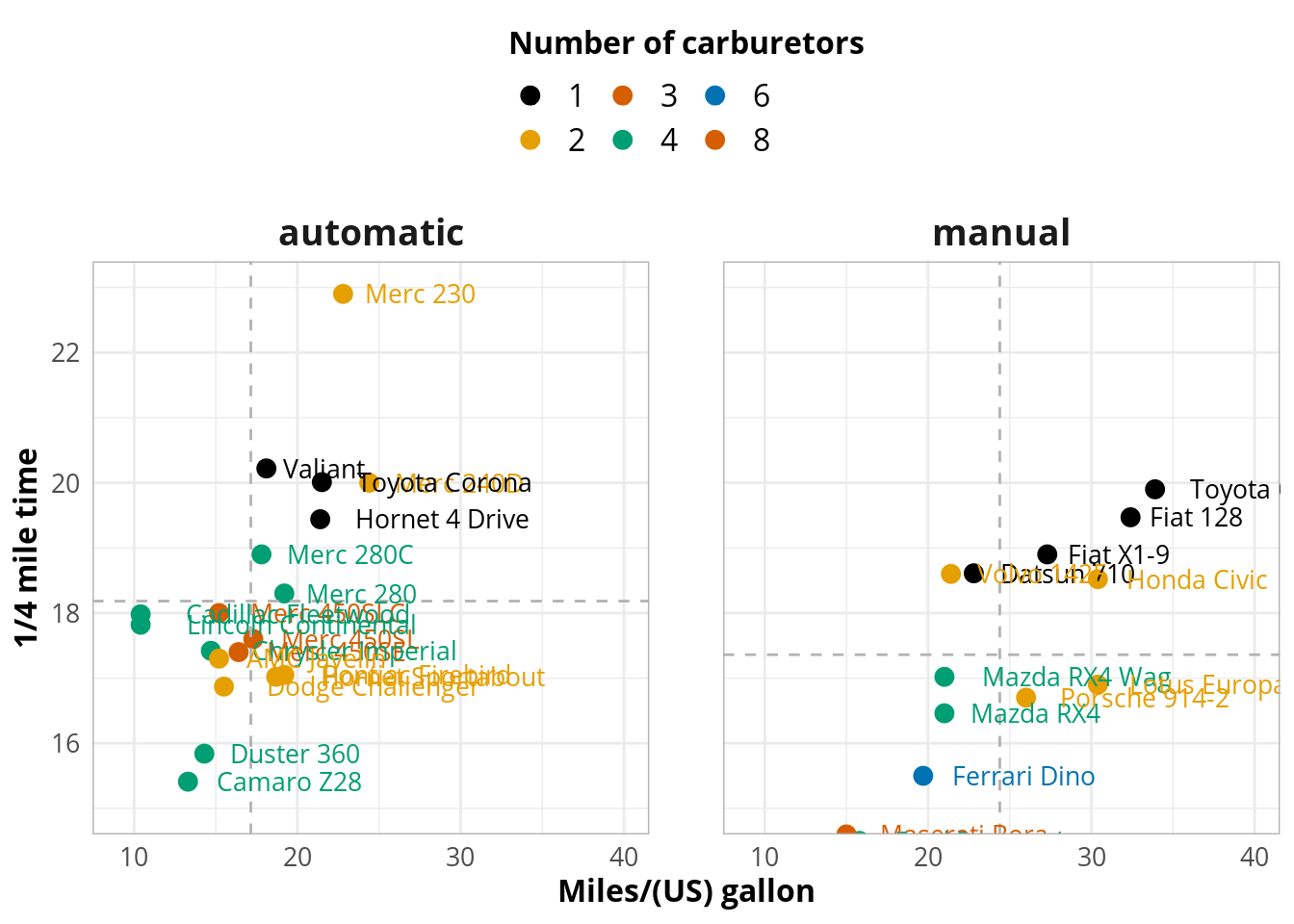
5.2 Obtaining the data and defining the colors
library(ggplot2)
library(laeken)
data(eusilc)
df <- eusilc
manual.color <- scale_color_manual(values=c("#CC79A7","#E69F00",
"#56B4E9","#000000",
"#009E73","#D55E00",
"#0072B2","#999999",
"#00FF00","Dim Grey",
"#56B4E9","#000000",
"#009E73","#D55E00",
"#0072B2","#999999"))
manual.fill <- scale_fill_manual(values=c("#CC79A7","#E69F00",
"#56B4E9","#000000",
"#009E73","#D55E00",
"#0072B2","#999999",
"#00FF00","Dim Grey",
"#56B4E9","#000000",
"#009E73","#D55E00",
"#0072B2","#999999"))5.3 Bar plot
5.3.1 Proportions of female and male headed households by region
library(ggplot2)
library(grid)
tbl <- data.frame(prop.table(table(df$db040,df$rb090),1) * 100)
tbl$Freq <- round(tbl$Freq, 1)
# ordering the levels of rdb040 by femla share
df.order <- subset(tbl, Var2 == 'female')
df.order <- df.order[order(df.order$Freq),]
tbl$Var1 <- factor(tbl$Var1, levels = df.order$Var1)
# bar plot
ggplot(tbl, aes(x=Var2,y=Freq,label=Freq,fill=Var1)) +
geom_bar(position="dodge", stat="identity") +
geom_text(position = position_dodge(width=1), vjust=-0.5, size=3) +
labs(x="xlab",y="ylab") +
labs(title="plot title") +
theme(axis.text.x = element_text(angle=90, vjust= 0.5)) +
coord_cartesian(ylim=c(0,75)) +
annotate("text", x = 1.5, y = 65, label = "Some text here") +
theme(legend.title=element_blank()) +
theme(legend.key.size = unit(3, "mm")) +
theme(legend.position="top") +
manual.fill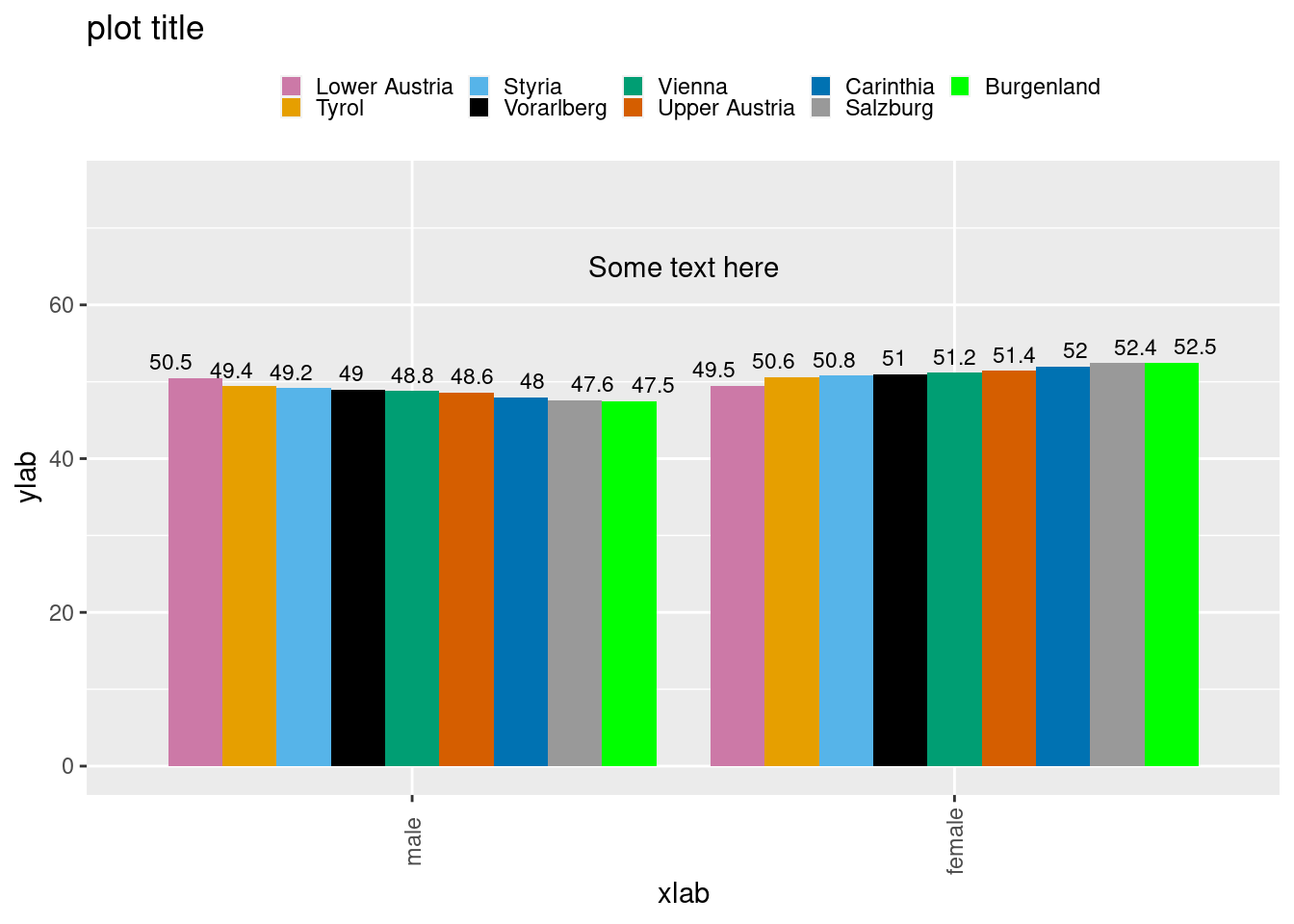
5.4 Line Plot
df <- read.csv("https://vincentarelbundock.github.io/Rdatasets/csv/Ecdat/Cigarette.csv")
df$year <- as.numeric(df$year)
cnames <- subset(df, year == 1995)
ggplot(df,
aes(x=year,y=packpc,group=state,color=state)) +
geom_line() +
geom_point() +
scale_x_continuous(breaks=1985:1995) +
geom_text(data=cnames, aes(x=year,y=packpc,label=state),
size=4, hjust=-0.2) +
labs(x="year",y="number of packs per capita") +
labs(title="The Cigarette Consumption Panel Data Set") +
theme(legend.position="none")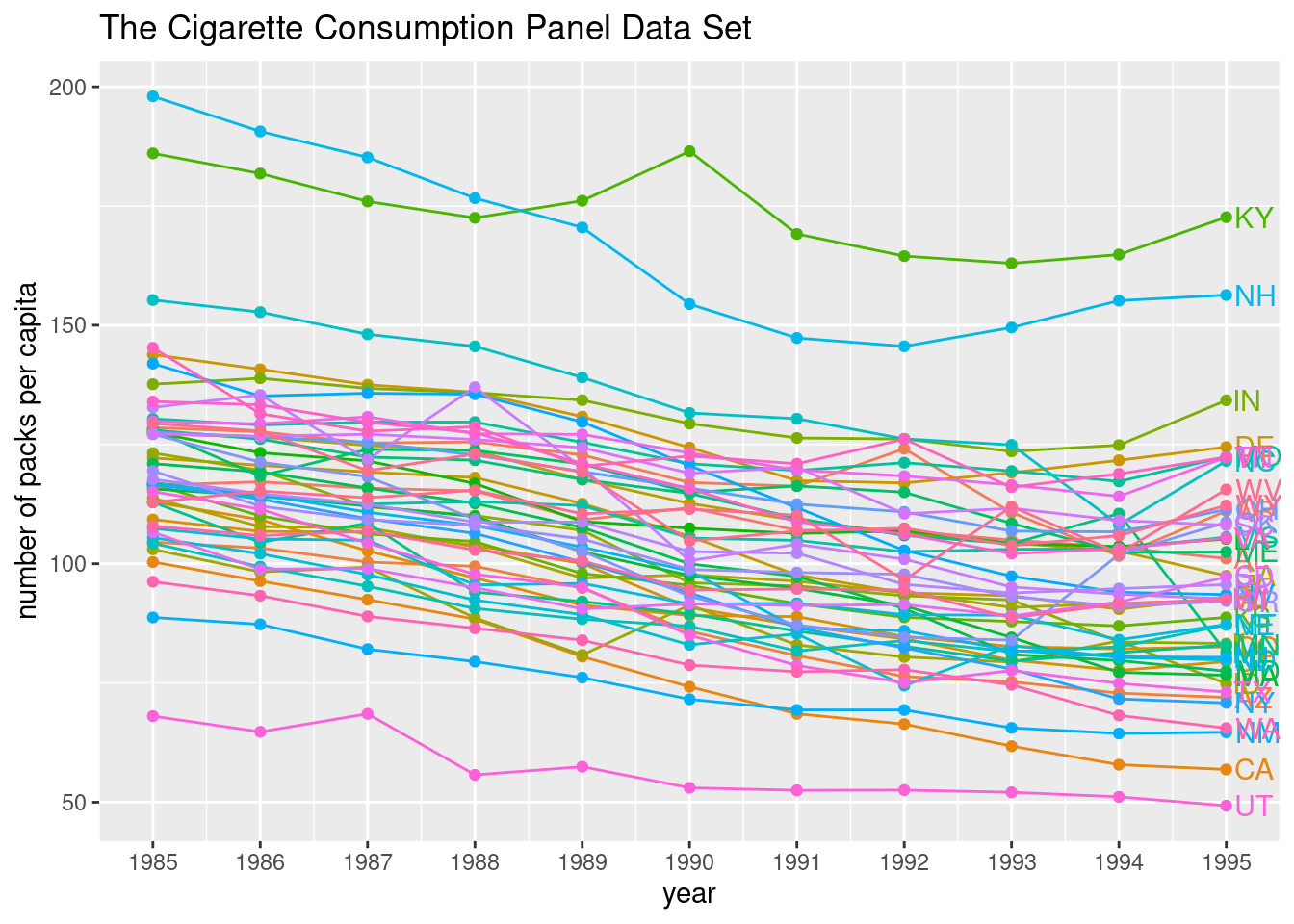
5.5 Scatter plots
5.5.1 Age vs. household income by region and sex
df <- eusilc
# aggregate a table
tbl <- aggregate(eqIncome~db040+rb090+age,
median,
data=df)
# subset to cover ages 18-75
tbl <- subset(tbl, age > 17 & age < 76)
# plot
ggplot(tbl, aes(x=age,y=eqIncome,color=rb090)) +
geom_point() +
facet_wrap(~db040) +
geom_smooth(method=lm, se=TRUE) +
labs(x="xlab",y="ylab") +
labs(title="plot title") +
theme(axis.text.x = element_text(angle=90, vjust= 0.5)) +
theme(legend.title=element_blank()) +
theme(legend.key.size = unit(3, "mm")) +
theme(legend.position="top") +
manual.color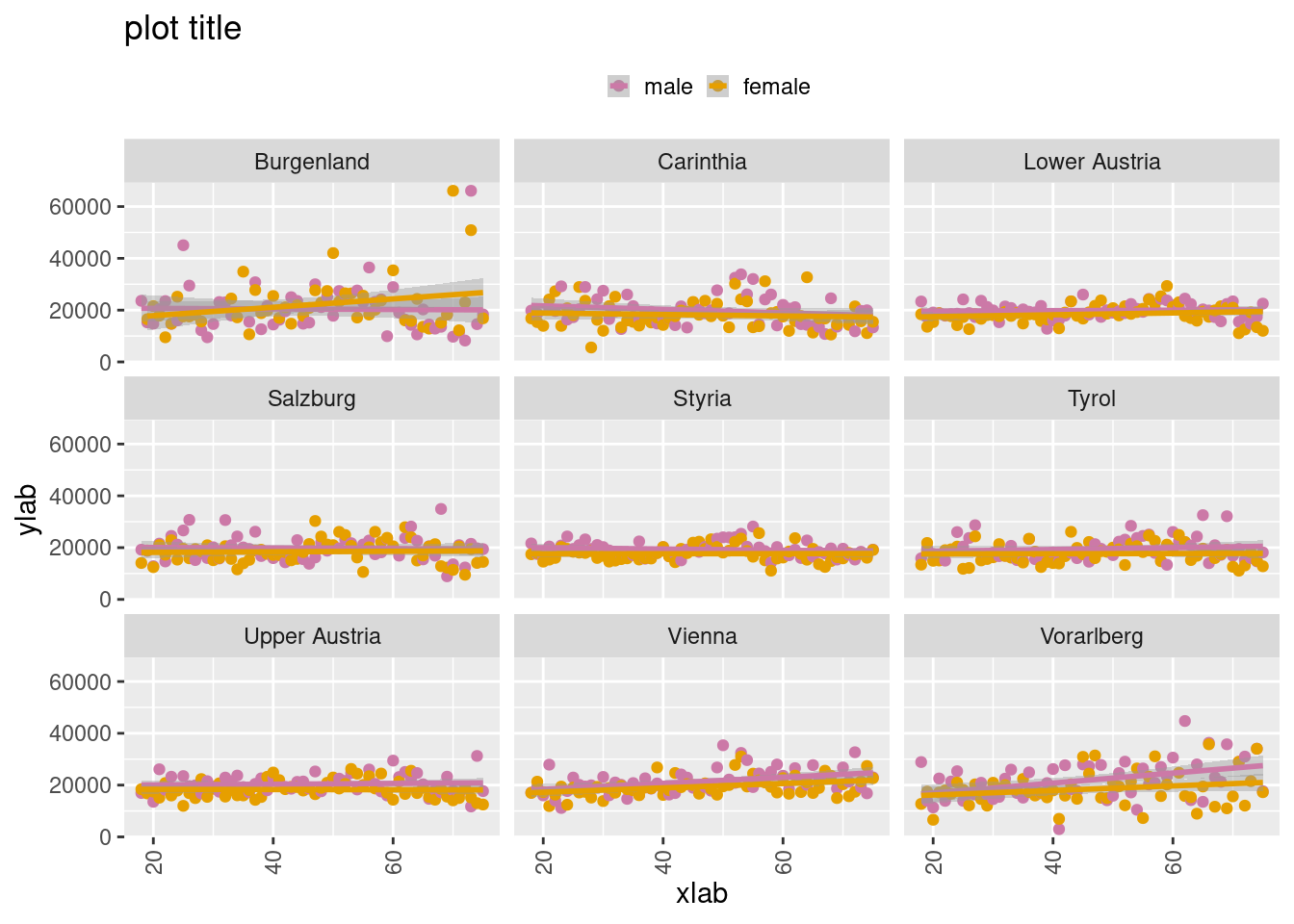
5.6 Distributions by ageclass, region and gender
5.6.1 As a density plot
df <- eusilc
df$age_class[df$age < 18] <- '0-17'
df$age_class[df$age >= 18 & df$age < 25] <- '18-24'
df$age_class[df$age >= 25 & df$age < 55] <- '26-54'
df$age_class[df$age >= 55 & df$age < 65] <- '55-64'
df$age_class[df$age >= 65] <- '65 <'
ggplot(df, aes(x=eqIncome,fill=age_class)) +
geom_density(alpha=.4) +
facet_grid(rb090~db040) +
labs(x="xlab",y="ylab") +
labs(title="plot title") +
theme(axis.text.x = element_text(angle=90, vjust= 0.5)) +
theme(legend.title=element_blank()) +
theme(legend.key.size = unit(3, "mm")) +
theme(legend.position="top") +
coord_cartesian(xlim=c(0,30000)) +
manual.fill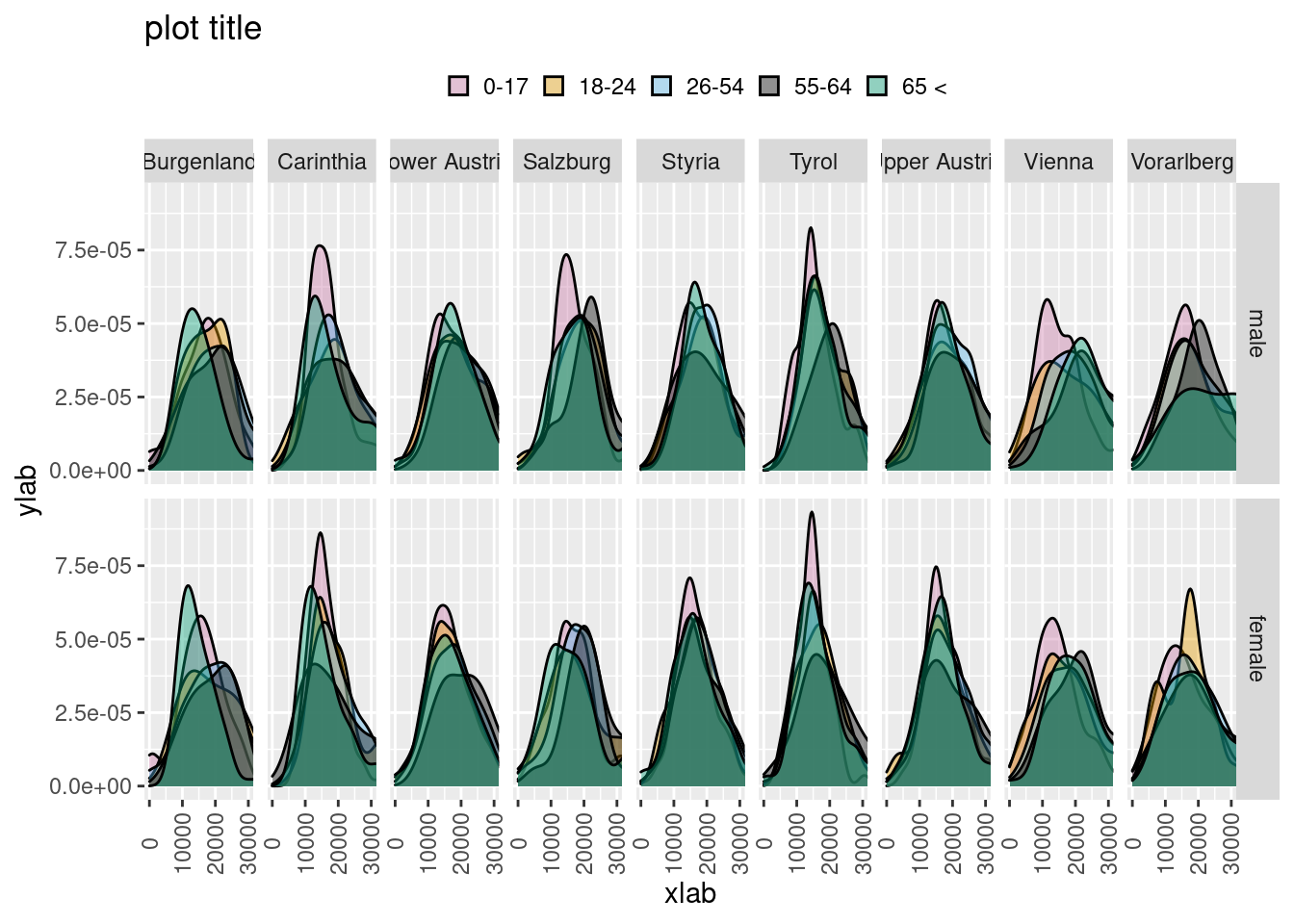
5.6.1.1 As a box plot
ggplot(df, aes(x=age_class,y=eqIncome, fill=rb090)) +
geom_boxplot() +
facet_wrap(~db040) +
labs(x="xlab",y="ylab") +
labs(title="plot title") +
theme(axis.text.x = element_text(angle=90, vjust= 0.5)) +
theme(legend.title=element_blank()) +
theme(legend.key.size = unit(3, "mm")) +
theme(legend.position="top") +
coord_cartesian(ylim=c(0,30000)) +
manual.fill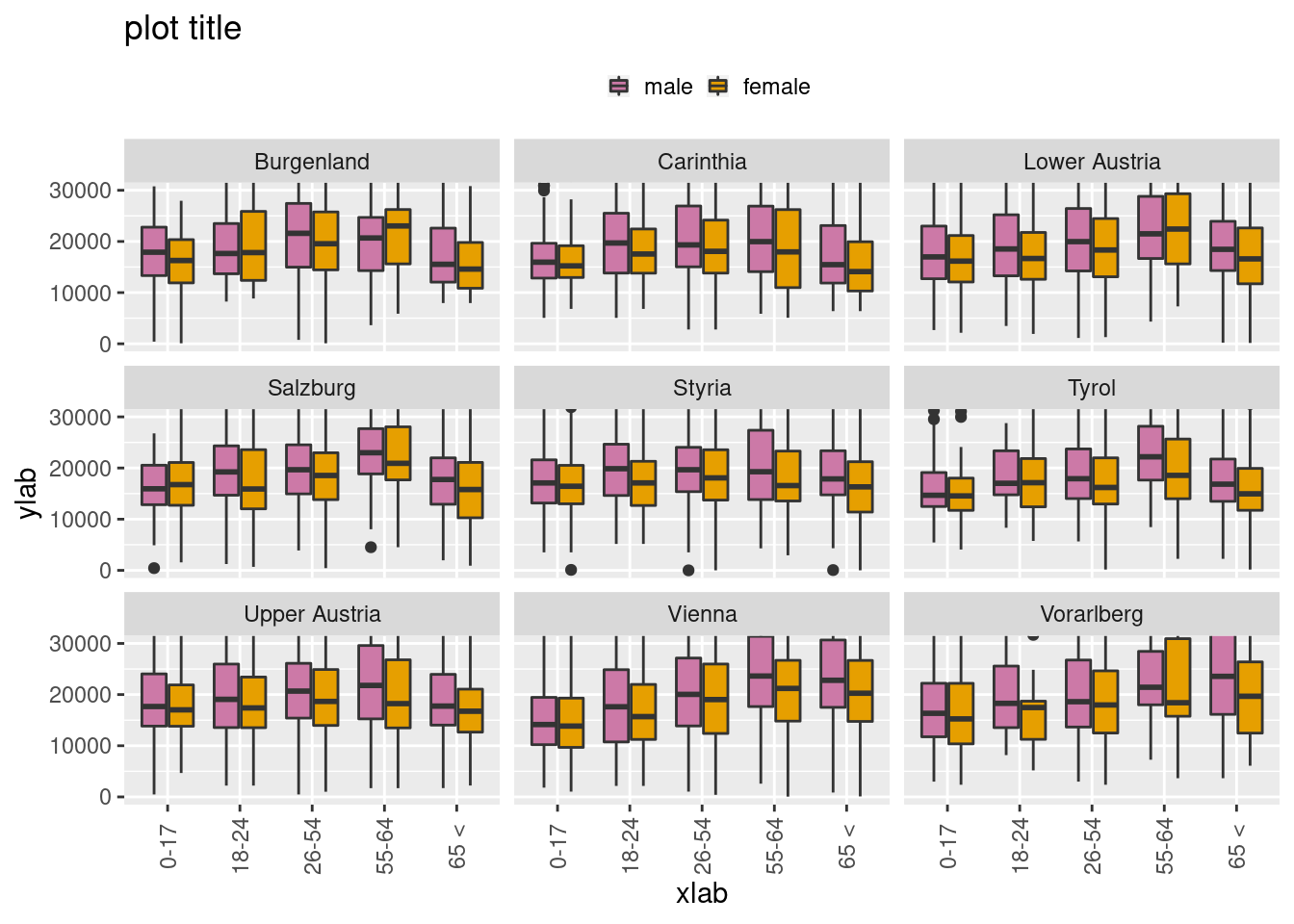
6 Maps with ggplot2
7 Survey
Resources
These analysis have been made using Life in Transition Survey 2. You can load the data in R with following line of code
download.file("http://www.ebrd.com/downloads/research/surveys/lits2.dta", "lits2.dta")
lits2 <- foreign::read.dta("lits2.dta")7.1 Survey design
library(survey)
d.df <- svydesign(id = ~SerialID,
weights = ~weight,
data = lits2)7.2 Plotting distributions
dpar <- par(mfrow=c(1,2))
svyhist(~q104a_1, design=d.df,
main="Survey weighted",
col="cadetblue")
lines(svysmooth(~q104a_1, d.df, bandwidth=5))
hist(lits2$q104a_1, main="Sample unweighted",
col="cadetblue",prob=TRUE)
lines(density(lits2$q104a_1, adjust=2))
par(dpar)7.3 Statistical tables
7.3.1 Mean Age by country with standard errors
# Create a data.frame out of table
t <- data.frame(svyby(~q104a_1, ~q102_1+country, design=d.df, svymean, na.rm=T))
# New names for data file
names(t) <- c("Sex","Country","mean_age","SE")
# Reorder the columns
t <- t[c(2,1,3,4)]
row.names(t) <- NULL
head(t)## Country Sex mean_age SE
## 1 2 1 50.61129 0.4037583
## 2 2 2 53.90229 1.5563343
## 3 8 1 53.78624 0.5789071
## 4 8 2 57.49704 0.9782967
## 5 11 1 43.08466 0.7683500
## 6 11 2 45.63880 0.59851347.3.2 GRAPH with Errorbars
library(ggplot2)
ggplot(t, aes(x=Country, y=mean_age, fill=Sex)) +
geom_bar(position="dodge", stat="identity") +
geom_errorbar(aes(ymin=mean_age-SE, ymax=mean_age+SE), width=.2,
position=position_dodge(.9)) +
coord_cartesian(ylim=c(35,65)) +
theme(axis.text.x = element_text(angle = 90, vjust = 0.5))7.4 Quantities by categorical variable
Lets use variable q301a
The economic situation in our country is better today than around 4 years ago
# manipulate string
library(stringr)
lits2$q301a <- as.factor(str_replace(lits2$q301a, "Don't know", "Dont know"))
# recode
lits2$q301a_rec[lits2$q301a == "Strongly agree"] <- "Agree"
lits2$q301a_rec[lits2$q301a == "Agree"] <- "Agree"
lits2$q301a_rec[lits2$q301a == "Strongly disagree"] <- "Disagree"
lits2$q301a_rec[lits2$q301a == "Disagree"] <- "Disagree"
lits2$q301a_rec[lits2$q301a == "Neither disagree nor agree"] <- "Neither nor"
lits2$q301a_rec[lits2$q301a == "Dont know"] <- "Dont know"
# set levels
lits2$q301a_rec <- factor(lits2$q301a_rec, levels=c("Agree","Neither nor","Disagree","Dont know"))
######
# Re-set the survey design
d.df <- svydesign(id = ~SerialID,
weights = ~weight,
data = lits2)
##
t2 <- data.frame(prop.table(svytable(~q301a_rec+country, d.df),2)*100)
t2 <- t2[!is.na(t2$Freq), ]
##
ggplot(t2, aes(x=country, y=Freq, fill=q301a_rec)) +
geom_bar(stat="identity") +
theme(legend.position="top") +
theme(axis.text.x = element_text(angle = 90, vjust = 0.5))8 Värit
8.1 Color brewer
Cindy Brewer: helping you choose better color scales for maps
library(RColorBrewer)
display.brewer.all()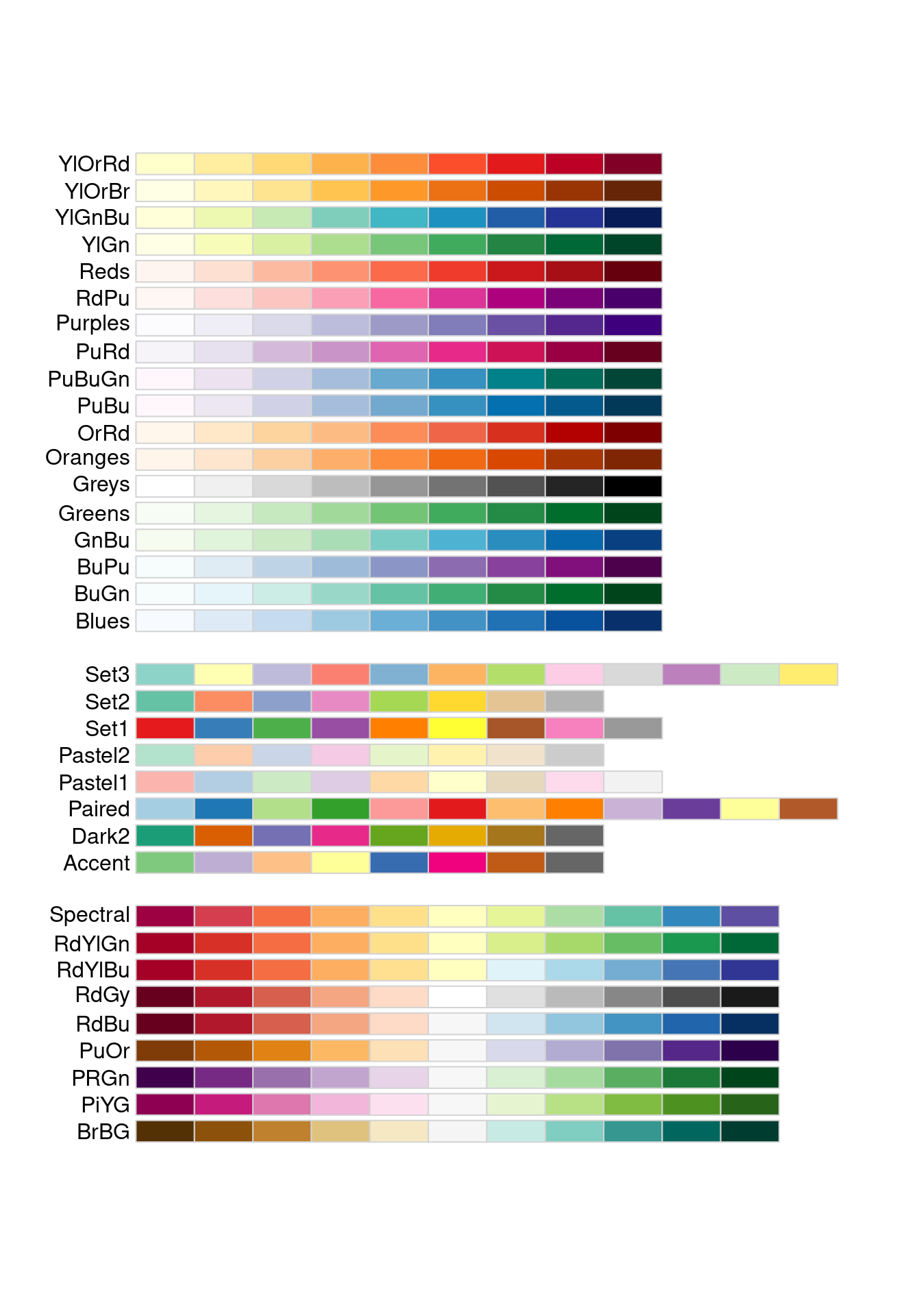
library(ggplot2)
mtcars$brands <- row.names(mtcars)
df <- mtcars[1:10,]
plot <- ggplot(df, aes(x=brands,y=cyl,fill=factor(carb)))
plot <- plot + geom_bar(stat="identity")
plot <- plot + scale_fill_brewer(palette="Set1")
plot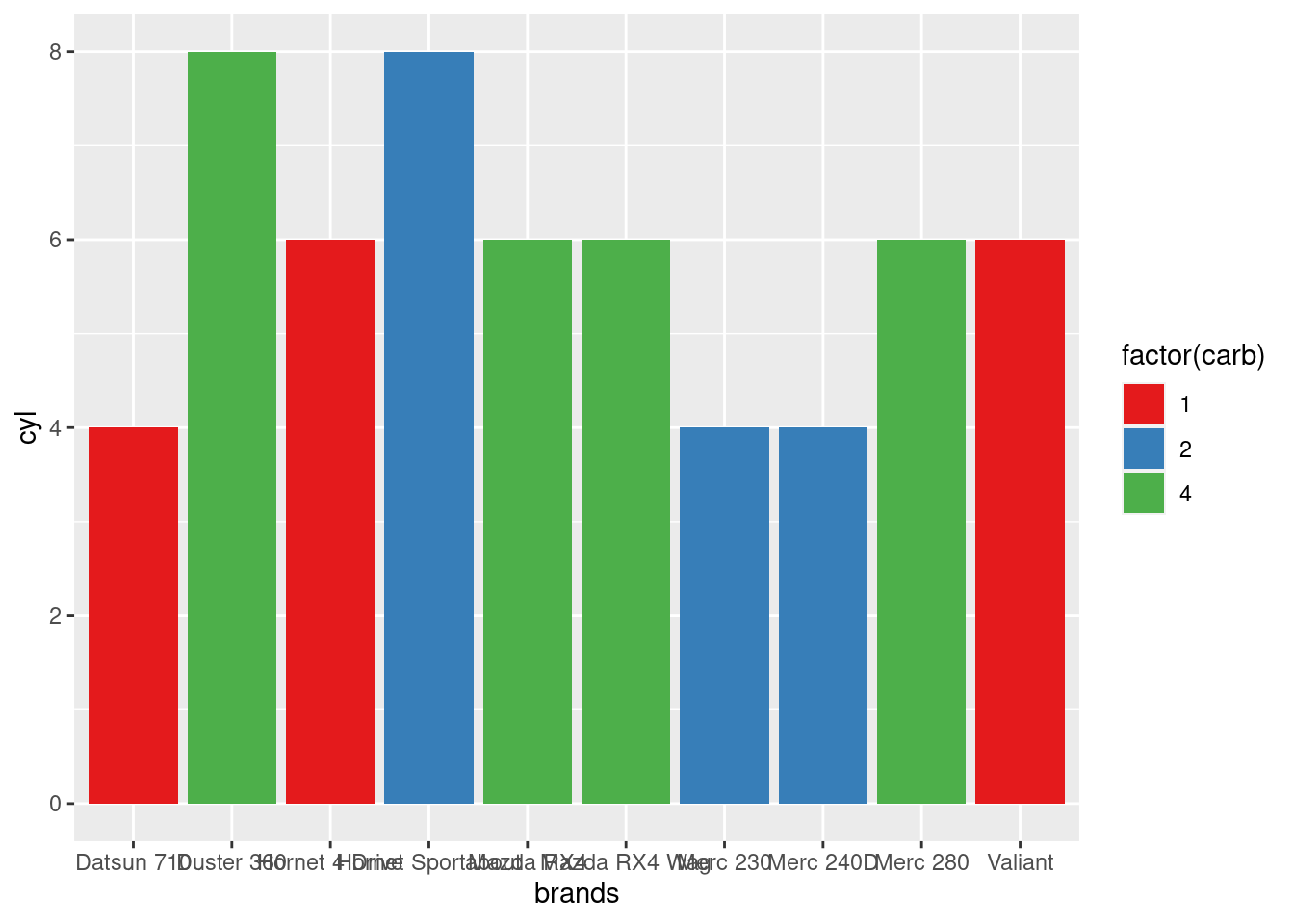
library(ggplot2)
mtcars$brands <- row.names(mtcars)
df <- mtcars[1:8,]
plot <- ggplot(df, aes(x=hp,y=qsec,color=brands,label=brands))
plot <- plot + geom_point()
plot <- plot + geom_text(family = "Gentium", hjust=-.1)
plot <- plot + scale_color_brewer(palette="Dark2")
plot <- plot + theme(legend.position = "none")
plot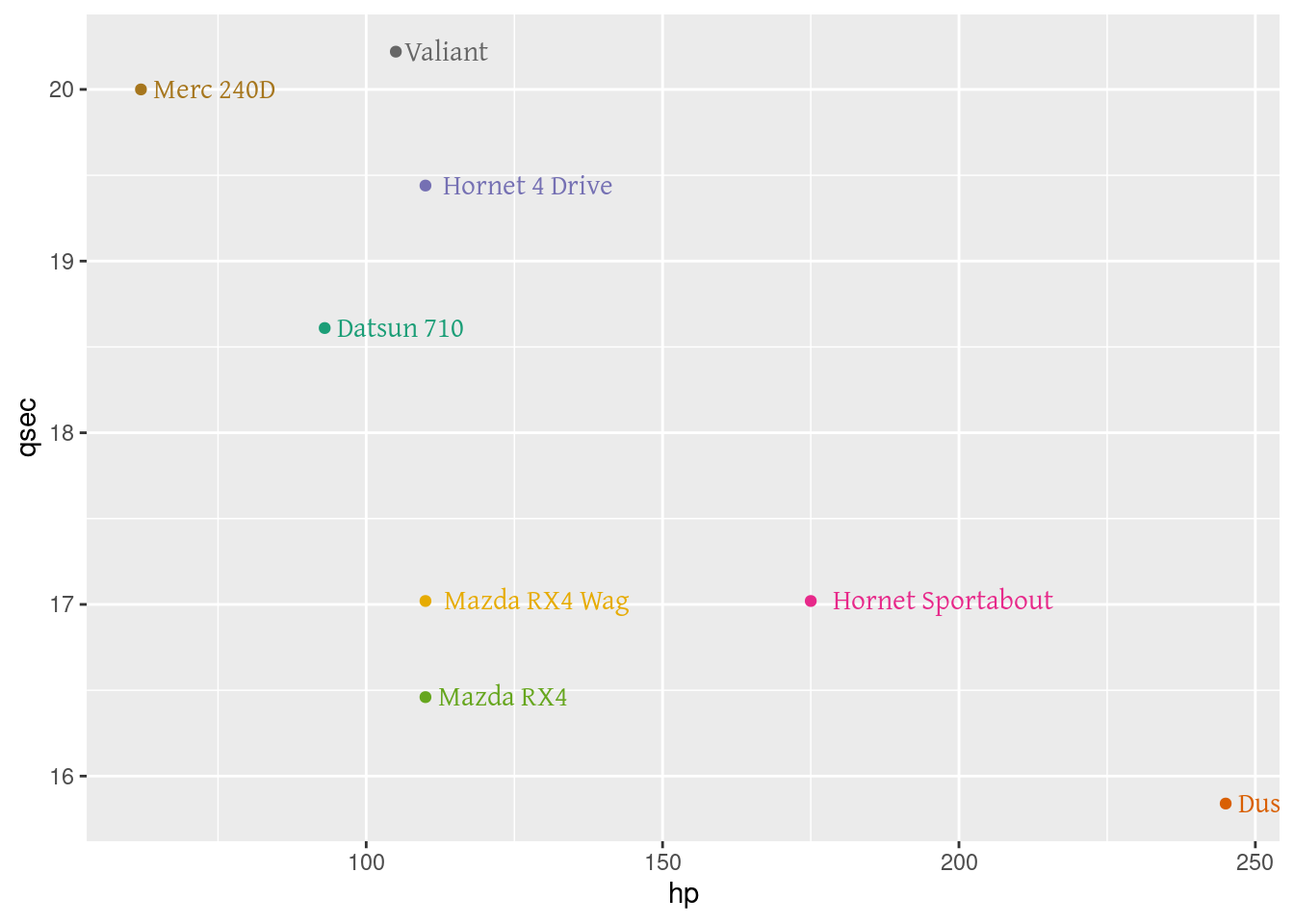
8.1.1 WesAnderson paletters
9 Webin raapimista
9.1 Wikipedia
library(XML)
theurl <- "http://en.wikipedia.org/wiki/Brazil_national_football_team"
tables <- readHTMLTable(theurl)
n.rows <- unlist(lapply(tables, function(t) dim(t)[1]))
tables[[which.max(n.rows)]]9.2 Sekalaisia
10 Regular expressions
10.1 Online
10.2 Sed
sed (stream editor) is a Unix utility that parses and transforms text, using a simple, compact programming language. sed was developed from 1973 to 1974 by Lee E. McMahon of Bell Labs,[1] and is available today for most operating systems
# add characters on the same line starting with "\owner"
sed -i '/^\\owner/ s/$/ }\n\\end{metadata}\n\n\\begin{metadata}{/' filex.txt10.3 Kansanedustajien nimet
t1 <- Sys.time()
library(rvest)
library(stringr)
# generoidaan kaikkien kansanedustajien sivujen linkit
edustajat <- read_html("https://www.eduskunta.fi/FI/kansanedustajat/nykyiset_kansanedustajat/Sivut/default.aspx")
txt <- html_text(edustajat)
linkit <- unlist(stringr::str_extract_all(txt, "https://www.eduskunta.fi/FI/kansanedustajat/Sivut/[0-9]+.aspx"))
# Luodaaan tyhjä data.frame, jossa kaikki mahdolliset otsiko
# dfs <- Filter(function(x) is(x, "data.frame"), mget(ls()))
# lapply(dfs)
#
# nimet <- vector()
# for (nro in 1:length(dfs)){
# nimi <- dfs[[nro]][[1]]
# nimet <- c(nimet,nimi)
# }
#
# uniikit_nimet <- unique(nimet)
#
# uniikit_nimet <- gsub(":", "",uniikit_nimet)
# uniikit_nimet <- gsub("-", "",uniikit_nimet)
# uniikit_nimet <- gsub(" ", "_",uniikit_nimet)
# uniikit_nimet <- gsub(" / ", "_",uniikit_nimet)
# uniikit_nimet <- tolower(uniikit_nimet)
uniikit_nimet <- c("nimi", "puhelin", "sähköposti", "kotisivu", "ammatti_/_arvo", "vaalipiiri",
"toimielinjäsenyydet_ja_tehtävät", "aiemmat_toimielinjäsenyydet_ja_tehtävät",
"eduskuntaryhmä", "koko_nimi", "syntymäaika_ja_paikka", "kotikunta", "koulutus",
"työura_/_elämänkertatietoja", "vanhemmat", "puoliso", "kunnalliset_luottamustehtävät",
"muut_luottamustehtävät", "sotilasarvo", "toimielinjäsenyydet_ja_tehtävät_2", "nimi_2",
"koulutus_2", "avustaa_kansanedustajia", "puhelin_2", "sähköposti_2", "lapset",
"aiemmat_vaalipiirit", "aiemmat_eduskuntaryhmät", "kansanedustajana",
"valtiolliset_luottamustehtävät", "kansainväliset_luottamustehtävät",
"edustajan_julkaisut", "lisätietoja", "tehtävät_eduskuntaryhmässä",
"ministeri", "arvonimet", "luottamustehtävät_vallilaryhmän_yhtiöissä",
"muut_hallinto_ja_luottamustehtävät", "hallituksen_jäsen", "edustajantoimi_keskeytynyt",
"lisäksi_omistan", "pääministeri", "kouluttaja_ja_konsultti",
"euroa", "palkkiota_mistään_toimielimestä")
dat <- as.data.frame(setNames(replicate(length(uniikit_nimet),
character(0), simplify = F),
letters[1:length(uniikit_nimet)]), stringsAsFactors=FALSE)
names(dat) <- uniikit_nimet
for (linkki in linkit){
edustaja <- read_html(linkki)
cast <- html_nodes(edustaja, "#kansanedustajaMenu, .upper66")
txt <- html_text(cast)
d <- txt[1]
d <- gsub(pattern = "\\t", replacement = "", x = d)
d <- gsub(pattern = "\\r", replacement = "", x = d)
# d <- gsub(pattern = "\\s\\s", replacement = "", x = d)
nimi <- unlist(stringr::str_extract_all(d, "[a-öA-Ö]+\\s?([a-öA-Ö]+)?-?\\s?(\\/?|ja)\\s?([a-öA-Ö]+)?:\\n"))
arvo <- unlist(strsplit(x = d, split = "[a-öA-Ö]+\\s?([a-öA-Ö]+)?-?\\s?(\\/?|ja)\\s?([a-öA-Ö]+)?:\\n",
perl = TRUE))[-1]
ddd <- data.frame(nimi,arvo, stringsAsFactors = FALSE)
ddd$nimi <- stringr::str_trim(ddd$nimi)
ddd$nimi <- gsub(":", "",ddd$nimi)
ddd$nimi <- gsub("-", "",ddd$nimi)
ddd$nimi <- gsub(" ", "_",ddd$nimi)
ddd$nimi <- gsub(" / ", "_",ddd$nimi)
ddd$nimi <- tolower(ddd$nimi)
# lisää duplikaatteihin
ddd$nimi <- ifelse(duplicated(ddd$nimi),paste0(ddd$nimi,"_2"),ddd$nimi)
ddd$arvo <- stringr::str_trim(ddd$arvo)
ddd$arvo <- gsub("\\n", "",ddd$arvo)
dddd <- tidyr::spread(ddd, nimi, arvo)
dat <- bind_rows(dat,dddd)
}
duration <- Sys.time() - t110.4 Sosiaalidemokraattisten puolueiden kannatus Pohjoismaissa
# __ _ _
# / _|(_) __ _ _ _ _ __ ___ / |
# | |_ | | / _` || | | || '__|/ _ \| |
# | _|| || (_| || |_| || | | __/| |
# |_| |_| \__, | \__,_||_| \___||_|
# |___/
#
#
#%#% --------------------------------------- #%#%
#%#% Scrape wikipedia
#%#% --------------------------------------- #%#%
if (!file.exists("./local_data/df_fi.RData")){
# install.packages("pxweb")
library(pxweb)
library(dplyr)
library(ggplot2)
library(ggrepel)
library(stringr)
library(tidyr)
library(rvest)
years <- c(1954,1958,1962,1966,1970,1972,1975,1979,1983,1987,1991,1995,1999,2003,2007,2011,2015)
dd <- data.frame()
for (y in years){
urli <- paste0("https://fi.wikipedia.org/wiki/Eduskuntavaalit_",y)
htmli <- read_html(urli)
luokka <- "table.prettytable"
if (y %in% c(1958,1979,1983,1987,1991,2011,2015)) luokka = "table.wikitable"
n = 2
if (y %in% c(1983,1987)) n = 3
if (y %in% c(2007,2011,2015)) n = 1
d <- html_table(html_nodes(htmli, luokka)[[n]], fill = T)
d <- d[-1,]
d <- d[c(2,5)]
names(d) <- c("party","value")
d <- d[ with(d, grepl("Sosialidemokraattinen Puolue", party)),]
new_row <- data.frame(party = d$party[1],
value = d$value[1],
year = y)
dd <- rbind(dd,new_row)
}
ddd <- dd
dd$value <- gsub(pattern = "%", replacement = "", x= dd$value)
dd$value <- gsub(pattern = ",", replacement = ".", x= dd$value)
dd$value <- gsub(pattern = ",", replacement = ".", x= dd$value)
dd$value <- str_trim(dd$value)
dd$value <- as.factor(dd$value)
dd$value = as.numeric(levels(dd$value))[dd$value]
dd$party <- NULL
dd$country <- "Finland"
df_fi <- dd
save(df_fi, file="./local_data/df_fi.RData")
} else load("./local_data/df_fi.RData")
# Sweden
if (!file.exists("./local_data/df_se.RData")){
library(XML)
library(rvest)
html <- html("https://sv.wikipedia.org/wiki/Resultat_i_val_till_Sveriges_riksdag")
d = html_table(html_nodes(html, "table")[[1]], fill = T)
names(d) <- d[1,]
d <- d[-1,]
d <- gather(d, party, value, 2:13)
df_se <- d %>% filter(grepl("Social",party),
grepl("demokraterna",party)) %>%
mutate(År = as.integer(År),
value = gsub(x=value, pattern =",", replacement = "."),
value = as.factor(value),
value = as.numeric(levels(value))[value]) %>%
filter(År >= 1950) %>%
rename(year = År) %>%
mutate(country = "Sweden") %>%
select(-party)
save(df_se, file="./local_data/df_se.RData")
} else load("./local_data/df_se.RData")
# Norway
if (!file.exists("./local_data/df_no.RData")){
html <- html("https://no.wikipedia.org/wiki/Stortingsvalg_1945%E2%80%93")
dd <- data.frame()
tbs <- 2:18
ys <- c(2013,2009,2005,2001,1997,1993,1989,1985,1981,1977,1973,1969,1965,1961,1957,1953,1949,1945)
for (y in 1:length(tbs)){
d = html_table(html_nodes(html, "table")[[tbs[y]]], fill = T)
if (y != 1) d <- d[c(1,4)]
if (y == 1) d <- d[c(2,4)]
names(d) <- c("party","value")
d <- d[ with(d, grepl("Arbeiderparti", party)),]
new_row <- data.frame(party = d$party[1],
value = d$value[1],
year = ys[y])
dd <- rbind(dd,new_row)
}
dd <- dd[!is.na(dd$value),]
dd$value <- gsub(pattern = ",", replacement = ".", x= dd$value)
dd$value <- gsub(pattern = ",", replacement = ".", x= dd$value)
dd$value <- str_trim(dd$value)
dd$value <- as.factor(dd$value)
dd$value = as.numeric(levels(dd$value))[dd$value]
dd$party <- NULL
dd$country <- "Norway"
df_no <- dd
save(df_no, file="./local_data/df_no.RData")
} else load("./local_data/df_no.RData")
# Denmark
# https://da.wikipedia.org/wiki/Folketingsvalg#Folketingsvalg_efter_1953-grundloven
if (!file.exists("./local_data/df_dk.RData")){
years <- c(1957,1960,1964,1966,1968,1971,1973,1975,1977,1979,1981,1984,1987,1988,1990,1994,1998,2001,2005,2007,2011,2015)
dd <- data.frame()
for (y in years){
urli <- paste0("https://da.wikipedia.org/wiki/Folketingsvalget_",y)
htmli <- read_html(urli)
luokka <- "table.wikitable"
if (!y %in% 2011){
n = 1
if (y == 2015) n = 4
d <- html_table(html_nodes(htmli, luokka)[[n]], fill = T)
if (!y %in% c(1984,1987,1988,1990,1994,1998,2001,2005,2007,2011,2015)) d <- d[c(1,4)]
if (y %in% c(1984,1987,1988,1990,1994,1998,2001,2005,2007,2015)) d <- d[c(2,5)]
} else {
n = 3
d <- html_table(html_nodes(htmli, luokka)[[n]], fill = T)
d <-
d <- d[1:21,c(2,5)]
}
names(d) <- c("party","value")
d <- d[ with(d, grepl("Socialdemok", party)),]
new_row <- data.frame(party = d$party[1],
value = d$value[1],
year = y)
dd <- rbind(dd,new_row)
}
ddd <- dd
dd$value <- gsub(pattern = "%", replacement = "", x= dd$value)
dd$value <- gsub(pattern = ",", replacement = ".", x= dd$value)
dd$value <- gsub(pattern = ",", replacement = ".", x= dd$value)
dd$value <- str_trim(dd$value)
dd$value <- as.factor(dd$value)
dd$value = as.numeric(levels(dd$value))[dd$value]
dd$party <- NULL
dd$country <- "Denmark"
df_dk <- dd
save(df_dk, file="./local_data/df_dk.RData")
} else load("./local_data/df_dk.RData")
# Iceland
# http://px.hagstofa.is/pxen/pxweb/en/Ibuar/Ibuar__kosningar__althingi__althurslit/KOS02121.px
if (!file.exists("./local_data/df_ic.RData")){
d <- read.csv("./local_data/KOS02121(1).csv", stringsAsFactors = FALSE, sep=";", skip = 1)
df_ic <- d %>% filter(Category %in% "Percentage of valid votes") %>%
gather(., key = year, value = value, 3:17) %>%
mutate(year = gsub(pattern="X",replacement="",x = year),
year = as.integer(year),
# for value
value = as.factor(value),
value = as.numeric(levels(value))[value]
) %>%
filter(!is.na(value),
grepl("Social Democratic",Political.organisation)) %>%
mutate(country = "Iceland") %>%
select(-Category,-Political.organisation)
save(df_ic, file="./local_data/df_ic.RData")
} else load("./local_data/df_ic.RData")
df_nr <- rbind(df_fi,df_se,df_no,df_dk,df_ic)
#%#% --------------------------------------- #%#%
#%#% Plot
#%#% --------------------------------------- #%#%
p <- ggplot(df_nr, aes(x=year,y=value,group=country))
# disable smooth..
# p <- p + geom_smooth(aes(fill = country),method="loess", size = .5, alpha=.15, linetype="dashed")
p <- p + geom_line(aes(color=country),size=1)
# p <- p + ggrepel::geom_text_repel(data=df_nr %>% group_by(country) %>%
# filter(year == max(year)) %>%
# mutate(value = round(value,1)) %>%
# ungroup(),
# aes(x=year,y=value,label=paste(country,"\n",value,"%"))
# )
# p <- p + ggrepel::geom_text_repel(data=df_nr %>% group_by(country) %>%
# filter(year == min(year)) %>%
# mutate(value = round(value,1)) %>%
# ungroup(),
# aes(x=year,y=value,label=paste(country,"\n",value,"%"))
# )
p <- p + ggrepel::geom_label_repel(data=df_nr %>% group_by(country) %>%
filter(year == max(year)) %>%
filter(country %in% c("Finland","Norway")) %>%
mutate(value = round(value,1)) %>%
ungroup(),
aes(x=year,y=value,label=paste0(country,"\n",value,"%"),fill=country),
lineheight=.8, alpha=.7,size=3.5,color="black",
label.padding = unit(0.15, "lines"),nudge_x = 2, nudge_y=1.5
)
p <- p + ggrepel::geom_label_repel(data=df_nr %>% group_by(country) %>%
filter(year == max(year)) %>%
filter(!country %in% c("Finland","Norway")) %>%
mutate(value = round(value,1)) %>%
ungroup(),
aes(x=year,y=value,label=paste0(country,"\n",value,"%"),fill=country),
lineheight=.8, alpha=.7,size=3.5,color="white",
label.padding = unit(0.15, "lines"),nudge_x = 2, nudge_y=-1
)
p <- p + ggrepel::geom_label_repel(data=df_nr %>% group_by(country) %>%
filter(year == min(year)) %>%
filter(country %in% c("Finland","Norway")) %>%
mutate(value = round(value,1)) %>%
ungroup(),
aes(x=year,y=value,label=paste0(country,"\n",value,"%"),fill=country),
lineheight=.8, alpha=.7,size=3.5,color="black",
label.padding = unit(0.15, "lines"),nudge_x = 2, nudge_y=-1
)
p <- p + ggrepel::geom_label_repel(data=df_nr %>% group_by(country) %>%
filter(year == min(year)) %>%
filter(!country %in% c("Finland","Norway")) %>%
mutate(value = round(value,1)) %>%
ungroup(),
aes(x=year,y=value,label=paste0(country,"\n",value,"%"),fill=country),
lineheight=.8, alpha=.7,size=3.5,color="white",
label.padding = unit(0.15, "lines"),nudge_x = 2, nudge_y=1
)
# VALUES AND YEARS FOR THE YEARS IN BETWEEN
# p <- p + ggrepel::geom_text_repel(data=df_nr %>% group_by(country) %>%
# filter(year != c(min(year),max(year))) %>%
# mutate(value = round(value,1)) %>%
# ungroup(),
# aes(x=year,y=value,label=paste(year,"\n",value,"%")),size=2.5,alpha=.5
# )
p <- p + theme(legend.position="none")
p <- p + theme_minimal() + theme(legend.position = "none") +
theme(text = element_text(family = fontti, size= 12)) +
theme(legend.title = element_blank()) +
theme(axis.text.y= element_text(size = 10)) +
theme(axis.text.x= element_text(size = 10, angle=90, vjust= 0.5)) +
theme(axis.title = element_text(size = 11, face = "bold")) +
theme(legend.text= element_text(size = 11)) +
theme(strip.text = element_text(size = 11, face = "bold")) +
guides(colour = guide_legend(override.aes = list(size=4))) +
theme(panel.border = element_rect(fill=NA,color="grey70", size=0.5,
linetype="solid"))
# p <- p + scale_color_manual(values=c(palette_distinctive1,palette_distinctive1))
# p <- p + scale_fill_manual(values=c(palette_distinctive1,palette_distinctive1))
# p <- p + scale_fill_grey(start = .65, end = .05)
# p <- p + scale_color_grey(start = .65, end = .05)
p <- p + scale_fill_manual(values=c("black","grey80","grey30","grey60","grey10"))
p <- p + scale_color_manual(values=c("black","grey80","grey30","grey60","grey10"))
# p <- p + scale_color_manual(values=c("white","white","black","black","black"))
p <- p + scale_x_continuous(breaks = sort(unique(df_nr$year)))
p <- p + labs(x="",y="Share of votes cast in parliamentary elections (%)")10.5 Maiden erikielisten nimien skreippaaminen wikipediasta
# load packages
library(RCurl)
library(XML)
library(stringr)
# 1. Lets parse the table of all sovereign states from here: http://en.wikipedia.org/wiki/List_of_sovereign_states
# to get url's to English page of each state
html <- getURL("http://en.wikipedia.org/wiki/List_of_sovereign_states", followlocation = TRUE)
# parse html
doc <- htmlParse(html, asText=TRUE)
tbls <- xpathSApply(doc, "//table[@class='sortable wikitable']", saveXML)
x <- tbls[nchar(tbls) == max(nchar(tbls))]
str <- unlist(strsplit(x, '</span><a href="/wiki/'))
str <- gsub(pattern = '\\\"(.*)', replacement = '', x = str, perl = TRUE)
str <- gsub(pattern = '\\\"(.*)', replacement = '', x = str, perl = TRUE)
str <- gsub(pattern = '(\\\n)(.*)', replacement = "", x = str, perl = TRUE)
countries <- str[-1]
# add ones not included in the list, but can be found in countrycode-package
countries <- c(countries,"Aland_Islands")
urls <- paste0("http://en.wikipedia.org/wiki/",countries)
# 2. Now we have the links, so lets go through each country page and
# fetch the links to each language version of that page - and get there the
# language name in English AND country name in the language in question
for (i in 1:length(urls)){
# download html
html <- getURL(urls[i], followlocation = TRUE)
# parse html
doc <- htmlParse(html, asText=TRUE)
lists <- xpathSApply(doc, "//div[@class='body']/ul", saveXML)
x <- lists[nchar(lists) == max(nchar(lists))]
str <- unlist(strsplit(x, "title="))[-1]
str <- gsub(pattern = '(\\\n)(.*)', replacement = "", x = str, perl = TRUE)
str <- gsub(pattern = "(lang)(.*)", replacement = "", x = str, perl = TRUE)
str <- str_replace_all(str, '\\\"','')
str <- str_replace_all(str, ' – ',';')
str <- str[grep(";", str)]
str <- str_trim(str)
str <- str_replace_all(str, "'","")
## as there are some strings with no ; marks, we get rid of them
dd <- read.table(text = str, sep = ";", colClasses = "character")
names(dd) <- c(countries[i],"lang")
if (i == 1) dat <- dd
dat <- dat[!duplicated(dat["lang"]),]
if (i != 1) dat <- merge(dat,dd,by="lang", all.x=TRUE)
}
# finally, transpose the data
data <- as.data.frame(t(dat[-1]))
# create language names from row.names of the dat and refine them a bit
new_names <- paste0("country.name.",tolower(as.character(dat[[1]])))
new_names <- str_replace_all(new_names, " ", ".")
new_names <- str_replace_all(new_names, "/", ".")
new_names <- str_replace_all(new_names, "\\.{3}", ".")
new_names <- str_replace_all(new_names, "\\.{2}", ".")
new_names <- str_replace_all(new_names, "\\)", "")
new_names <- str_replace_all(new_names, "\\(", "")
names(data) <- new_names
# then the english country names from row.names of the data
english.name <- row.names(data)
## remove the .x's and .y's
english.name <- str_replace_all(english.name, "\\.x", "")
english.name <- str_replace_all(english.name, "\\.y", "")
## apply the new naMES
data$country.name.english <- english.name
for (i in 1:ncol(data)) {
data[[i]] <- as.character(data[[i]])
}
# load the wiki-key data to be able to combine with original data in prep.R script
library(RCurl)
GHurl <- getURL("https://raw.githubusercontent.com/muuankarski/data/master/world/wiki_key.csv")
wiki <- read.csv(text = GHurl)
wiki[2][wiki[2] == ""] <- NA
data <- merge(data,wiki[1:2],by="country.name.english")
data <- data[c(max(ncol(data)),1:max(ncol(data))-1)]
write.csv(data, "data/wiki_names.csv", row.names = FALSE)
## Colnames to exclude in countrycode()-function
# cat(paste(shQuote(names(data), type="cmd"), collapse=", "))11 Templates
11.1 R
#' ---
#' title:
#' author: Markus Kainu
#' date: "started Dec 28 2016 - Last updated: **`r Sys.time()`**"
#' output:
#' html_document:
#' theme: yeti
#' toc: true
#' toc_float: true
#' number_sections: yes
#' code_folding: hide
#' ---
#'
#'
#' ***
#' **Manual**
#'
#' Look [analysis.R](analysis.R) for the R-code and [plot](plot/)-folder for plots
#'
#' Below each plot you can find links for downloading the data behind the plot in .csv format and particular plot in six different formats:
#'
#' 1. bitmap png for screen
#' 1. pdf vector with no fonts embedded
#' 1. pdf vector with fonts embedded (using [`extrafont`](https://cran.r-project.org/web/packages/extrafont/index.html)-package)
#' 1. pdf vector with fonts included as polygons (using [`showtext`](https://cran.rstudio.com/web/packages/showtext/index.html)-package)
#' 1. svg vector
#' 1. svg vector with fonts included as polygons (using [`showtext`](https://cran.rstudio.com/web/packages/showtext/index.html)-package)
#'
#' Vector formats can be edited in for example with [Inkscape](https://inkscape.org/en/) or Adobe Illustrator.
#'
#' <b>Please email <a href="mailto:markus.kainu@gmail.com?Subject=Specify subject here" target="_top">Markus Kainu</a>
#' for any further requirements regarding the graphs, eg. point sizes, dimensions, colors etc.!</b>
#'
#' ***
#'
#+ knitr_setup, include=F
library(knitr)
knitr::opts_chunk$set(list(echo=TRUE,
eval=TRUE,
cache=FALSE,
warning=FALSE,
message=FALSE))
opts_chunk$set(fig.width = 10, fig.height = 10)
#+ setup, include=FALSE
library(stringr)
library(tidyverse)
library(extrafont)
loadfonts()
library(svglite)
library(showtext)
library(hrbrthemes)
# create folders
if (!file.exists("./plot/")) dir.create("./plot/", recursive = TRUE)
if (!file.exists("./data/")) dir.create("./data/", recursive = TRUE)
if (!file.exists("./local_data/")) dir.create("./local_data/", recursive = TRUE)
save_plot_data <- function(plot_object="p",
df_name = df,
figname = "fig1_vote_shares",
plot_width = 11,
plot_height = 8,
plot_width_png = 1500,
plot_height_png = 1200){
# Save data
write.csv(df_name, file=paste0("./plot_csv/",figname,".csv"), row.names = F)
# Save plot
# png
png(paste0("./plot/",figname,".png"), width=plot_width_png, height=plot_height_png, res = 150)
print(get(plot_object))
graphics.off()
# pdf
pdf(paste0("./plot/",figname,".pdf"), width=plot_width, height=plot_height, useDingbats = FALSE, onefile = FALSE)
print(get(plot_object))
graphics.off()
# embed
embed_fonts(file=paste0("./plot/",figname,".pdf"),
outfile=paste0("./plot/",figname,"_emb.pdf"))
# svg
svglite(paste0("./plot/",figname,".svg"), width=plot_width, height=plot_height, standalone = TRUE)
print(get(plot_object))
graphics.off()
# showtext pdf & svg
showtext.auto() ## automatically use showtext for new devices
pdf(paste0("./plot/",figname,"_st.pdf"), width=plot_width, height=plot_height, useDingbats = FALSE, onefile = FALSE)
print(get(plot_object))
graphics.off()
svglite(paste0("./plot/",figname,"_st.svg"), width=plot_width, height=plot_height, standalone = TRUE)
print(get(plot_object))
graphics.off()
showtext.auto(FALSE) ## turn off if no longer needed
}
print_download_links <- function(figname){
cat(paste0(
" \n",
"\n",
"- Download data in [.csv](./plot_csv/",figname,".csv) \n",
"- Download plot in [.png](./plot/",figname,".png) \n",
"- Download plot in [.pdf](./plot/",figname,".pdf) \n",
"- Download plot in [.pdf](./plot/",figname,"_emb.pdf) with fonts embedded\n",
"- Download plot in [.pdf](./plot/",figname,"_st.pdf) with fonts as shapes\n",
"- Download plot in [.svg](./plot/",figname,".svg) \n",
"- Download plot in [.svg](./plot/",figname,"_st.svg) with fonts as shapes\n"
))
}
#'
#' # Plot1
#'
#+ plot1
dat <- mtcars
save_plot_data(plot_object="p",
df_name = dat1,
figname = paste0("fig2_4t",loop_data$var[i]),
plot_width = 11,
plot_height = 8,
plot_width_png = 1650,
plot_height_png = 1150)
print_download_links(figname = paste0("fig2_4t",loop_data$var[i]))
#'
#' ***
#'
#' # sessioninfo()
#+ sessioninfo
sessionInfo()12 Knitr
Knitr-asetukset
library(knitr)
opts_chunk$set(list(echo=FALSE,eval=TRUE,cache=TRUE,warning=FALSE,message=FALSE))
# tai
library(knitr)
opts_chunk$set(list(echo=FALSE,eval=TRUE,cache=TRUE,warning=FALSE,message=FALSE,fig.height=4,dev="pdf",opts_chunk$set(fig.path = paste('figure/my-prefix-', org, sep = ''))))12.1 Controlling plot output in html
use the following chunk settings
{r example_poland, out.width=c('300px','300px','300px','300px','300px','300px'), fig.show = "hold", fig.height=8, fig.width=6}library(ggplot2)
resolutions <- c("60","20")
nuts_levels <- c(1,2,3)
for (res in resolutions){
load(url(paste0("http://data.okf.fi/ropengov/avoindata/eurostat_geodata/rdata/NUTS_2013_",
res,
"M_SH.RData")))
map.df <- get(paste0("NUTS_2013_",res,"M_SH"))
for (lev in nuts_levels){
m <- ggplot(data=map.df[grepl("PL", map.df$NUTS_ID) & nchar(as.character(map.df$NUTS_ID)) == lev+1,],
aes(x=long,y=lat,group=group)) +
theme(title=element_text(size=20)) +
geom_polygon(color="black",fill=NA) +
labs(title=paste0("Poland at NUTS-",lev," level \n at 1:",res," mln resolution"))
print(m)
}
}12.2 Reproducible documents with R & knitr
This summary is prepared for FAO R-user group meeting on July 1, 2015
### Resources
#### R-packages
- knitr - framework for embedding R code in markdown/latex
- rmarkdown - utilities for converting Rmarkdown/Rlatex into pdf/html/docx etc
- Sweave - the older knitr for purely latex pdf outputs
12.2.0.1 Books
12.2.0.2 Quick tutorials
12.2.1 Example 1: R-script into html/pdf
script.R looks like this:
#' This is a R-script that demonstrates how to create plots and tables
#' Load the libraries first
library(knitr)
library(ggplot2)
#' Create a markdown table
kable(head(cars))
#' You can also set chunk options like this
#+ chunk-label, fig=TRUE, height=5, width=FALSE
ggplot(cars, aes(x=speed, y=dist, color=speed)) +
geom_point() + geom_smooth(method="loess")Use following commands for conversion in R:
knitr::spin("script.R")
# Or
rmarkdown::render("script.R")
# Or
rmarkdown::render("script.R", "html_document")or in Rstudio simply press Crtl+Shift+k (or click the icon above the script editor)
Demo files are here:
- input: script.R
- pdf output: script.pdf
- html output: script.html
12.2.2 Example 2: Academic paper
Rmd. source here:
To see different formats rendered click the links from below:
- pdf: https://github.com/muuankarski/faosyb_paper/raw/master/faosyb_paper.pdf
- html: http://htmlpreview.github.io/?https://raw.githubusercontent.com/muuankarski/faosyb_paper/master/faosyb_paper.html
- Word: https://github.com/muuankarski/faosyb_paper/raw/master/faosyb_paper.docx
- Libreoffice: https://github.com/muuankarski/faosyb_paper/raw/master/faosyb_paper.odt
Templates
12.2.3 Example 3: Jekyll povered website
12.3 Example 3:: FAO Statistical Pocketbook
13 Pandoc
pandoc -s -S --number-section --toc --from=markdown+yaml_metadata_block -H koko_css_mukaan.css source.md -o output.html
#
pandoc -s -S --number-section --toc --from=markdown+yaml_metadata_block --css css_mukana_hakemistossa.css source.md -o output.html
# pdf
pandoc --toc --number-section --latex-engine=xelatex -V lang=english -V papersize:a4paper -V documentclass=scrartcl input.md -o article_demokr.pdf
# word
pandoc --toc --number-section input.md -o article_demokr.docx
pandoc --toc --number-section -s -S -H /home/aurelius/web/css/rmarkdown.css -r markdown+grid_tables+table_captions+yaml_metadata_block paperi-gaudeamus.md -o index.html14 Jekyll
Start a new site
jekyll new site
cd site
jekyll serve
# => Now browse to http://localhost:4000Asetukset ko. dokkariin
jekyll serve --watch --baseurl''
# tai
jekyll serve --watchCopyright © 2016 Markus Kainu. No rights reserved.

This work is licensed under a Creative Commons Attribution 4.0 International License.



